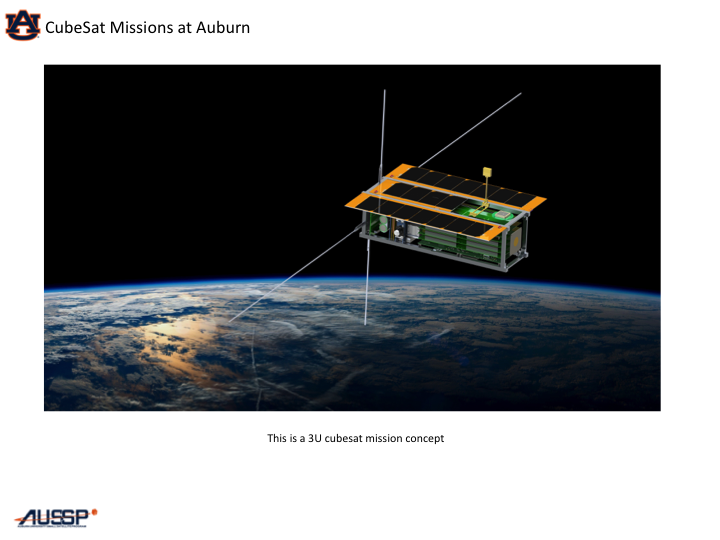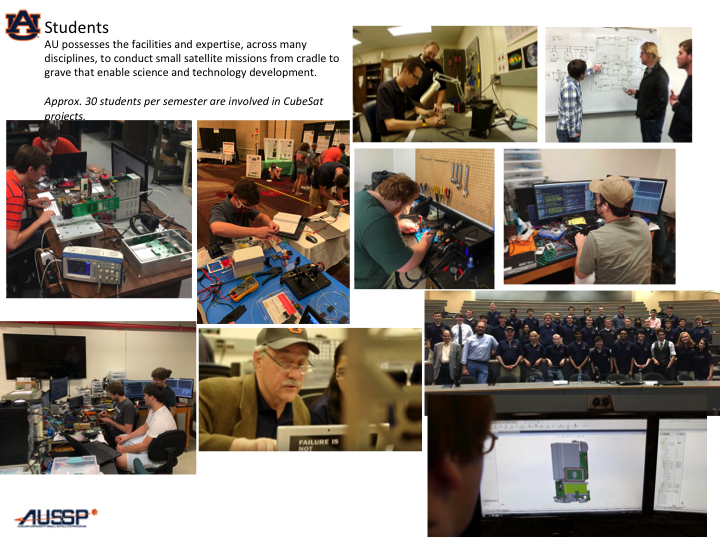COSAM News Articles 2022 March Spotlight on Auburn University’s Small Satellite Program: A mission to educate future leaders through space research
Spotlight on Auburn University’s Small Satellite Program: A mission to educate future leaders through space research
Imagine, as a student, having a once in a lifetime opportunity to build a satellite and launch it into space while on campus at Auburn University. One such opportunity does exist within the College of Sciences and Mathematics (COSAM), and it’s recruiting new students for future space missions!
The Auburn University Small Satellite Program (AUSSP) is both a workforce development program and a space science and technology research program. In AUSSP, students get to design, build, test, and operate CubeSats - small, cube-shaped satellites - that are launched into orbit around Earth where they perform science missions.
J-M Wersinger, Associate Professor Emeritus in the Department of Physics, started the Auburn University Student Space Program (AUSSP) in 2001 with a desire to create a meaningful workforce development program. Following an assignment with NASA’s education division, Wersinger began training students through AUSSP, and they initially completed 15 high altitude ballooning missions.
AUSSP then began its focus on launching CubeSats with a more well-defined, 4-inch cube size, giving students an opportunity to build something that they could launch into space. On October 28, 2011, AUSSP monumentally launched its first CubeSat, AubieSat-1, into space, making it the first CubeSat launch for the state of Alabama.
“The purpose of that initial AubieSat-1 project was to learn the process,” stated Michael Fogle, Associate Professor in the Department of Physics who joined AUSSP in 2015 as co-director alongside Wersinger. “It used a very simple radio communication through morse code which was operated from campus. It beeped War Eagle in orbit, and they actually heard it in amateur frequency bands all over earth.”
AUSSP’s scope began to broaden, as Fogle joined AUSSP and began working collaboratively with Wersinger and a group from the University of Alabama in Huntsville (UAH) who were interested in a National Science Foundation (NSF) proposal which involved building CubeSats to do science. “The goal was to measure terrestrial gamma ray flashes (TGFs) that occur in high-altitude storms in the tropics on Earth. To do this, we needed to make simultaneous measurements using two larger satellites, comparable to the size of a shoebox or two loaves of bread next to each other,” said Fogle.
This current project is titled Terrestrial Rays Analysis and Detection, or TRYAD. Funded through NSF, TRYAD has a large workforce development aspect to it where many satellite platform components are being built in house by students. The funding of the TRYAD proposal also brought a name change to the program, changing from Student Space Program to Small Satellite Program (maintaining AUSSP). AUSSP also partners with UAH on the NSF-funded project, who collaborated with NASA Goddard Space Flight Center to build the payload electronics portion.
Another AUSSP project called Quantum Encrypted Satellite-Based Transmission, or QUEST, involves a collaboration with Fogle and Mark Adams, Associate Professor in Electrical and Computer Engineering, and applies Department of Defense interests in secure communications to its mission. Auburn University was recently one of 10 universities chosen to participate in the Air Force Research Laboratory’s University Nanosatellite Program. “Through this two-year program, funding is provided for students to design small satellites, and the Air Force provides training and expertise,” said Dr. Fogle. “Students get to attend and present at conferences, gaining valuable experience. We’ll take a group of students to Logan, UT, to attend the Small Satellite Conference. It’s the largest conference for small satellites, and prime aerospace vendors will be in attendance.”
Fogle and Adams also have missions in the works involving a CubeSat testbed for the U.S. Army and a payload development project for the Missile Defense Agency.
AUSSP has on average 20-30 undergraduate students involved in projects at a given time, and Fogle says they are actively recruiting. “Students can apply for the program on our AUSSP website. We primarily have undergraduates in the program, and many are in engineering-specific majors, but we welcome any student applicant.”
Students work on AUSSP projects in various labs across campus including Leach Science Center, Broun Hall, and in the Advanced Engineering Lab located in the Research Park’s MRI building. As a part of developing missions, students are broken out into functional teams. “Every part of the satellite is a major subsystem, so we’ll have some students working on subsystem teams, and other students will work on program management teams,” said Fogle. “Most students volunteer, but we do typically hire 8-12 students to work full time on projects over the summer.”
Marketable skills that students gain through AUSSP include communicating in a collaborative, project-driven teamwork environment, developing time structure, creating deliverables, and writing documentation. Students also have an opportunity to develop more technical skills such as designing electrical circuit boards, software design, mechanical 3D modeling, thermal analysis, and communications radio design.
“We’ve had multiple industry leaders come and speak to our AUSSP students and tell them that their involvement in a program like this greatly benefits their future employers because through this training, they can hit the ground running in a new job,” said Fogle. “We’ve seen a lot of success with our students moving into good jobs – many jobs in the Huntsville area. We’ve had students intern and receive job offers at SpaceX, Dynetics, Teledyne Brown Engineering, Blue Canyon Technologies, Rocket Lab and other major aerospace companies. It’s a great opportunity for industry networking which can lead to future career opportunities.”
With a continued pursuit of space research and workforce development, AUSSP provides a memorable campus learning experience for students that can lead to impactful career opportunities.
For questions regarding AUSSP or the student application process, please contact Michael Fogle at mrf0006@auburn.edu.
Latest Headlines
-
02/12/2025
-
02/11/2025
-
02/10/2025
-
01/30/2025
-
12/03/2024



